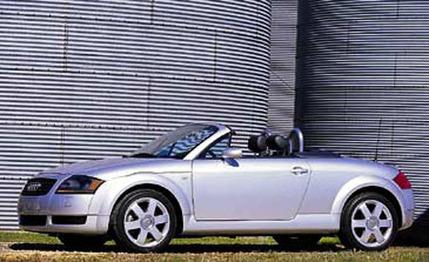
 Short Take Road Test
Short Take Road Test
More than four years ago, the Audi TT roadster was the cover story of our April 1996 issue. At the time, it was a show car, and pessimists could be forgiven for scoffing at Audi's assertion that the TT roadster would go into production with very few changes. How many times had we heard that one before?
Lo and behold, although the long-awaited roadster turned up a year late, it has met Audi's pledge -- it has arrived with most of Freeman Thomas's exterior styling touches in place. Even the mold-breaking art-deco interior design created by Romulus Rost is here. If you think the TT looks good as a coupe, it looks great as a roadster. (As long as the top is down, anyway. Our silver test TT roadster, a 180-horsepower front-wheel-drive model, had a black fabric hat that made it look a bit dowdy and top-heavy with it in place.)
Top down, though, you see those distinctive aluminum twin rollover bars behind the seats. (Interesting that the Honda S2000 has very similar twin hoops that are almost transparently integrated into the design, whereas Audi's rollover bars are a certified visual focal point.) The bars also add structural integrity to the roadster's Golf-derived platform, as does the use of thicker metal in the sill areas, reinforcements where the A- and B-pillars join the floor assembly, beefed-up strut-tower braces, and the use of the dashboard support beam as a structural member.
Impressive, but despite this gusseting, the TT roadster still manifests some minor cowl shake on rough roads, which are not hard to find in southern Michigan. The TT roadster feels as though it falls slightly below the ultra-stiff Porsche Boxster, but above the BMW Z3, in rigidity -- an observation confirmed only by the seat of our pants.
Aside from slight torque steer -- eliminated, of course, in the Quattro version, which offers all-wheel drive and a 225-hp version of the 1.8-liter, 20-valve four-cylinder -- there is little to complain about. Even 180 horsepower makes for an invigorating experience, with a 0-to-60-mph time of 7.2 seconds and a quarter-mile time of 15.7 seconds at 89 mph. The last front-drive TT coupe we tested ran from 0 to 60 mph in 6.9 seconds and did the quarter in 15.6 seconds at 90 mph. Likely the roadster's extra 240 pounds made the difference. (That weight difference is according to our own electronic scales -- Audi says an identically equipped roadster weighs just 144 pounds more than the coupe.)
We've liked the turbocharged 1.8-liter iron-block, aluminum-head four-cylinder in every Audi and VW application, and the TT roadster is no exception. The five-speed manual transmission is a bit notchy but not objectionable. A six-speed manual is standard in the 225-hp Quattro. As yet, no automatic is available, but one is expected.
The TT's manual top mechanism works simply -- twist one lever above the rearview mirror, and back goes the top, although raising and lowering it is much easier to accomplish from outside the car than inside. (A power top is optional on the front-drive TT roadster, standard on the Quattro.) The space required to house the lowered top and its mechanism eliminates the coupe's mostly theoretical rear seats -- no great loss, as we've yet to witness anyone voluntarily riding in the rear of a TT. The top also takes up a little trunk room. Still, the 7.8 cubic feet of space back there is plenty for a weekend's worth of soft luggage.
The glass rear window is large for a convertible, and it's heated. With the top up, the roadster is noisier than the coupe, but not that much. With the top down, wind buffeting is mildly annoying at highway speeds until you raise the wind blocker -- a glass panel that motors up into position fore of the rollover hoops, solving the problem.
The non-Quattro TT is nicely equipped as well, with air conditioning, cruise control, nappa leather seat trim, a 120-watt stereo, and power windows and locks as standard equipment. A navigation system and a Motorola hands-free cellular phone are optional, as is a six-disc CD changer. A $1450 Premium package consisting of xenon headlights, heated seats, and 225/45R-17 tires (standard on the Quattro) is a nice upgrade from the front-driver's already capable 205/55R-16 rubber. Our test car had the 17-inch Bridgestone Potenzas, which helped it achieve a respectable 0.87 g on the skidpad.
The 180-hp TT starts at $33,725; the 225-hp Quattro model opens at $39,496. Either one's a bargain for a rolling work of art.